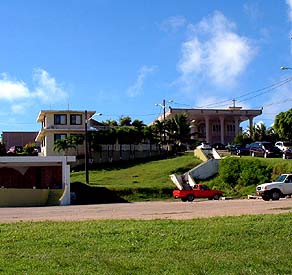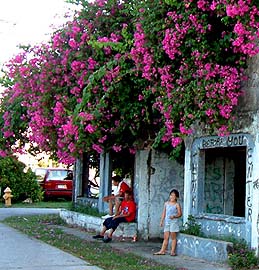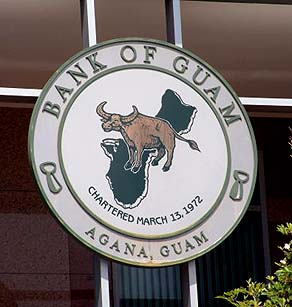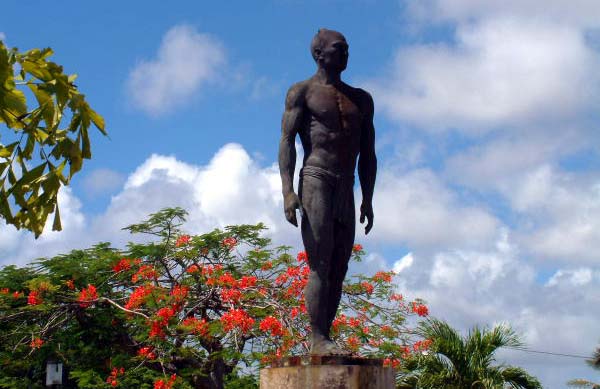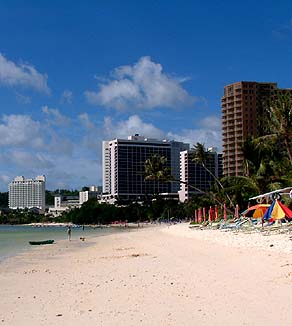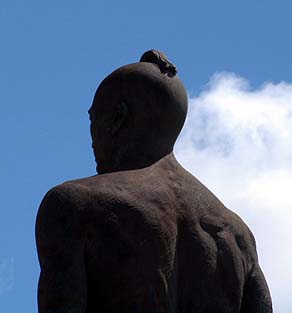 |
 |
 |
 |
||||
|
|
|
|
|
|
|
|
|
|
|
|||||||
|
|
|
|
The park behind Inarajan Bay is a community space.
|
|
|
The community of Inarajan comprises the entire municipality. Judy remarks,“When I refer to village, it’s the village proper, its Inarajan village proper, and then I might use the word ‘community,’ but more likely I would use the word ‘municipality.’ Malojloj and all the outlying areas would make up the community, because there aren’t that many people living in the village, in this little four-block area. Maybe 300 in this little village itself. But overall, as I think the mayor will tell you, there are over 3,000 people in Inarajan municipality, who are a part of this 'village' so to speak, but it’s more the community."
|
||
|
|
||
|
“And community in another sense could be the people who have roots to this village," Judy explains. "They are all over the island, but they can be a part of this community, and that’s what I want to bring back, as far as businessmen, the young people who have moved out and are no longer here physically, but they come back, because their parents are here, or they have roots here. “We have a few very active people, who are over-worked as far as being leaders in the community. Basically it’s the same people that run the Parish council, that run Gef Pa’go, that in some sense are off-and-on the municipal council. It’s drawing from the same pool of human resources, and I think we need to expand that. And it can be expanded. We have to develop."
|
|
|
Future generations at Inarajan.
|
"The hard part I think is to make people realize that the government can’t do it all, and people need to take leadership in their own civic activities. I think we’ve depended on the government for too long to do everything, and somehow that has to be changed. "We need to start getting some of the younger and middle-aged people involved. We have young businessmen who aren’t necessarily living here in the village before, but have roots here, and we need to get them to buy into the idea that they can come back and invest in this."
|
|
"I've researched what we call the reinvention of tradition. For example, we can see how many, many art forms were lost, and now they are being reclaimed, revived, re-articulated. One of the most fascinating I’ve found is Chamorro dance. Chamorro dance revivals began about 20 years ago. "We've been holding a Chamorro dance festival every year since 1992, but this year will be the biggest. We have four groups coming from Saipan, and one group coming from California — Chamorro groups. Plus six of our school and community groups, plus six professional groups. We were also able to get the master of Chamorro dance, the one who has been pushing it all these years, to organize it, so he’s doing a great job."
|
|
|
|
|
|
|
|
“There is a greater interest today in the perpetuation of Chamorro culture, particularly with this push for bilingualism,” Anne tells us. “It’s tied into language issues and an identity crisis, partly because of the increasing immigration that’s causing the Chamorro community to talk and think about the long-term picture. "I think that there is a greater interest in and greater appreciation for Chamorro culture. In the 1960s and '70s when I was growing up, the general attitude was — and people said it in public — ‘Oh, what’s the point in learning all this Chamorro stuff? It’s not going to get you anywhere in life.’ It was all very pro-American. You needed to learn English, you needed to be part of America. That was said to be the key to success."
|
||
|
|
||
|
"During the Vietnam war, there was not one single protest on Guam, and someone actually got beaten up for questioning U.S. involvement in the war. That kind of the pro-American feelings — in the '50s, '60s, '70s — were very strong. It was really in the '80s and '90s that people started to publicly question it. "That was very difficult. These people have a very difficult time questioning the military, questioning what’s happening to Guam, politically and culturally, because there’s a strong cultural sense of being inhospitable that makes people feel guilty. We’re culturally indoctrinated to be hospitable, and to be critical of a visitor is really taboo. "So people have a real anxiety over expressing their sense of our culture. Hence it has taken a long time for people to feel that it’s okay, that you can express it without being viewed as disrespectful."
|
|
|
|
"In the late 1980s, early 1990s there was a resurgence of the top-knot hair style. One of our senators now, before he became a 'certified' politician, was sort of a radical activist. He first he started out with a group called the Chamorro Che‘lu’s. Che‘lu means 'brother' or 'sister,' but his group, they were all young men, and really macho. They all had their hair cut to have a top-knot. "And that fueled a debate: 'Do I have to have a top-knot in order to be a Chamorro?' Some guys would wear their hair long and you wouldn’t know it was a top-knot until they pulled it up and you could see that they shaved the whole underpart. It was really threatening, and made some people really nervous. "But the fact that such people are now senators and they tend to get a lot of votes, that’s a sign to me that people are really taking issues of culture a lot more seriously, at least the grass roots population."
|
|
|
|
|
“Now I think there’s a much better appreciation of Chamorro culture, and people are saying, ‘Maybe we were wrong to raise our children that way. Maybe now with our grandchildren, we need to change directions'."
Gef Pa'go Cultural Village is one place where this turn of directions manifests on the land. We turn now to this place as an example of replanting local culture.
|
||
|
|
||
|
|
|
|
|
|

|
| Inarajan Home | Map Library | Site Map | Pacific Worlds Home |
|
|
|
|
|
|
|
|||
| Copyright 2003 Pacific Worlds & Associates • Usage Policy • Webmaster |
|||

